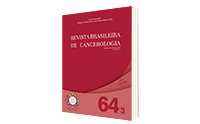Alterações Citogenético-Moleculares no Gene FOXO1 em uma Criança com Rabdomiossarcoma Alveolar: Relato de Caso
DOI:
https://doi.org/10.32635/2176-9745.RBC.2018v64n3.51Palavras-chave:
Rabdomiossarcoma, Criança, Translocação Genética, Hibridização in situ Fluorescente, Proteína Forkhead Box O1Resumo
Introdução: O rabdomiossarcoma (RMS) é o tumor de tecidos moles mais comum da infância. Pode ser classificado em dois subtipos principais: o rabdomiossarcoma alveolar (RMSa) e o embrionário (RMSe). No RMSa, o prognóstico é desfavorável quando comparado ao RMSe, necessitando de tratamento intensificado; dessa forma, a distinção entre ambos os subtipos é fundamental. Citogeneticamente, o RMSa apresenta translocações cromossômicas envolvendo o gene FOXO1 em 80% dos casos. A metodologia de hibridização in situ por fluorescência (FISH) tem sido muito utilizada para caracterizar o RMSa. Relato do caso: Paciente do sexo feminino, com 7 anos de idade, apresentou ao diagnóstico RMSa parameníngeo, sem metástase ao diagnóstico. A análise por meio de FISH mostrou a translocação envolvendo o gene FOXO1 e uma cópia extra desse gene. A paciente foi incluída no protocolo de tratamento do EpSSG, classificada como grupo de alto risco e recebeu quimioterapia e radioterapia. No final do tratamento, foi observada resposta parcial e iniciada quimioterapia de segunda linha. Não houve resposta clinicorradiológica e a paciente evoluiu com progressão de doença local refratária ao tratamento e óbito após um ano do diagnóstico. Conclusão: De acordo com o nosso conhecimento, é a primeira descrição de um caso de RMSa apresentando a translocação do gene FOXO1 e uma cópia extra desse gene em clones separados. São necessários ainda novos estudos, a fim de compreender melhor o significado prognóstico da presença dessas alterações.









